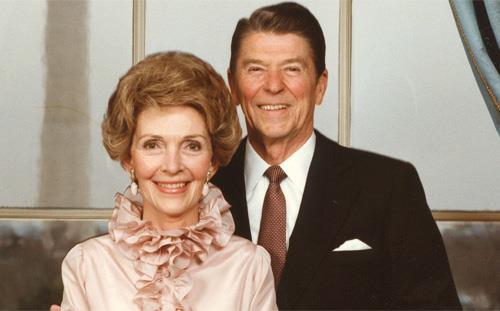
In a perfect world, America's president would not be a performer, and the presidency would not be a role.
It has been argued that's what America got with Donald Trump: a TV personality who often seemed to run the presidency like episodes of his TV show The Apprentice.
But as much as Trump promoted his brand in the Oval Office, a new four-part documentary titled The Reagans, which premieres Sunday at 8 p.m. ET on Showtime, suggests the late Ronald Reagan and his wife Nancy made Trump look like a bit player out of small-town community theater.
Directed by Matt Tyrnauer, The Reagans follows Ronald Reagan's life from his emergence as a movie star in 1937 through the end of his presidency more than a half-century later.
In the beginning, Tyrnauer's script explains, Hollywood constructed a Ronald Reagan it could sell to America. With the help of the powerful gossip columnist Louella Parsons, Reagan was packaged as the affable good guy next door, charming to everyone yet ready to fight for what's right.
That winning image, The Reagans argues, carried all through his life and carried him to the White House. Not only did much of the American public buy it, so did Reagan himself.
He was reassuring. He made people feel comfortable enough that even many who disagreed with his policies voted to make him their leader. In the 1984 election, he carried 49 states, which seems surreal in sharply divided 2020.
His name evokes reverence in Republican circles to this day.
It does not evoke reverence to Tyrnauer, who argues that Reagan used the nice-guy façade to enact and inspire policies that harmed minorities, harmed the environment, and empowered corporate America to make life harder for people in the lower economic classes. They widened the gap between the rich and the not-rich.
Tyrnauer also argues, as others have suggested before, that Reagan could not have done what he did without the powerful help of his wife Nancy, who is portrayed here as often being the wind beneath his wings.
Nancy Reagan took a lot of flak during Ronald's presidency because she ordered expensive china, and astrologers enthralled her. The Reagans recounts how Nancy Reagan would order Air Force One to fly at the time her astrologer said was most fortuitous, or to make policy announcements tomorrow instead of today because the stars were better aligned.
That kind of bizarre goofiness aside, Nancy Reagan also had shrewd political instincts and a ferocious drive to protect her husband not just from perceived enemies, but from friends and aides she felt were not serving him properly.
Those who got along with Nancy fared much better in the Reagan administration than those who did not, The Reagans argues, largely because she was paying attention to the nuts and bolts while he often preferred living in the world that had been built for him back in 1937.
In that world, America was the movie set, and he was galloping across the prairie to save the day.
Unfortunately, real-life intrusions like the Iran-Contra fiasco and the AIDS crisis, which he tried to ignore, became reminders that the world we want to see and the world that exists aren't always the same.
In the wider picture, Tyrnauer suggests, Reagan's mission to scale back what he considered the overreach of government into free enterprise had undercut the faith of Americans that government could shape the country and the world for the better.
Millions of people who resented some large or small government policy, from taxes to the Middle East to food stamps or zoning laws, felt encouraged to distrust or reject not just those policies but the institutions of government themselves.
That distrust forms the most significant link between the Reagan legacy and Donald Trump, who scored big with his call to "drain the swamp."
Laws and policies intended to help create a more equitable society were ridiculed as infringements on the freedom Reagan and Trump sold as having made America great.
The Reagans sidesteps the many differences between Reagan and Trump. Reagan came across as warm and charming, where Trump was abrasive. Reagan believed in compromise, where Trump wanted to rule by decree. Reagan had little time for details, and Trump micromanaged.
Still, Trump picked up the tapestry that Reagan began to weave three decades earlier, and Tyrnauer argues he also picked up Reagan's playbook: Create a media character with a white hat and ride it to the White House.